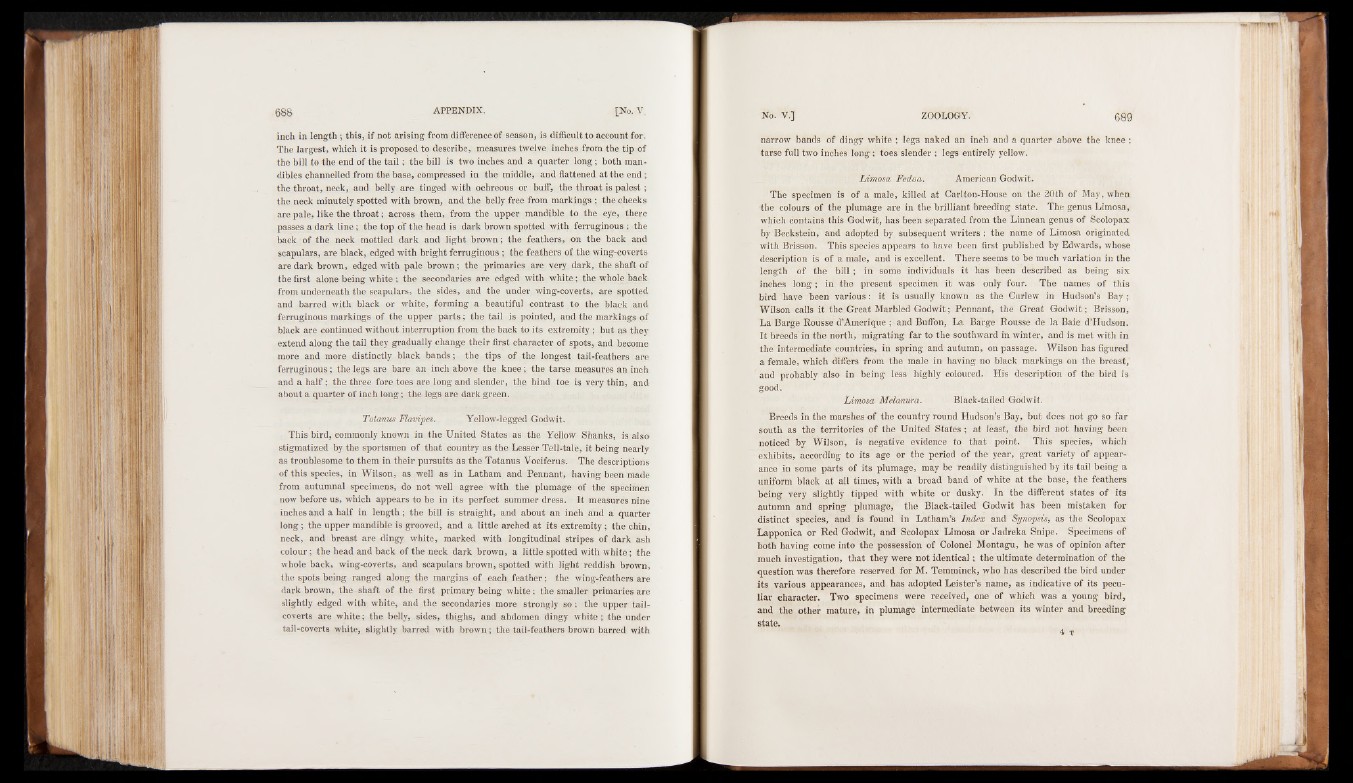
inch in length; this, if not arising from difference of season, is difficult to account for.
The largest, which it is proposed to describe, measures twelve inches from the tip of
the bill to the end of the ta il; the bill is two inches and a quarter long; both mandibles
channelled from the base, compressed in the middle, and flattened at the end;
the throat, neck, and belly are tinged with ochreous or buff, the throat is palest;
the neck minutely spotted with brown, and the belly free from markings ; the cheeks
are pale, like the throat; across them, from the upper mandible to the eye, there
passes a dark line; the top of the head is dark brown spotted with ferruginous ; the
back of the neck mottled dark and light brown; the feathers, on the back and
scapulars, are black, edged with bright ferruginous ; the feathers of the wing-coverts
are dark brown, edged with pale brown; the primaries are very dark, the shaft of
the first alone being white ; the secondaries are edged with white; the whole back
from underneath the scapulars, the sides, and the under wing-coverts, are spotted
and barred with black or white, forming a beautiful contrast to the black and
ferruginous markings of the upper parts; the tail is pointed, and the markings of
black are continued without interruption from the back to its extremity ; but as they
extend along the tail they gradually change their first character of spots, and become
more and more distinctly black bands; the tips of the longest tail-feathers are
ferruginous; the legs are bare an inch above the knee; the tarse measures an inch
and a half; the three fore toes are long and slender, the hind toe is very thin, and
about a quarter of inch long; the legs are dark green.
Totanus Flavipes. Yellow-legged Godwit.
This bird, commonly known in the United States as the Yellow Shanks, is also
stigmatized by the sportsmen of that country as the Lesser Tell-tale, it being nearly
as troublesome to them in their pursuits as the Totanus Yociferus. The descriptions
of this species, in Wilson, as well as in Latham and Pennant, having been made
from autumnal specimens, do not well agree with the plumage of the specimen
now before us, which appears to be in its perfect summer dress. It measures nine
inches and a half in length; the bill is straight, and about an inch and a quarter
long; the upper mandible is grooved, and a little arched at its extremity; the chin,
neck, and breast are dingy white, marked with longitudinal stripes of dark ash
colour; the head and back of the neck dark brown, a little spotted with white; the
whole back, wing-coverts, and scapulars brown, spotted with light reddish brown,
the spots being ranged along the margins of each feather; the wing-feathers are
dark brown, the shaft of the first primary being white; the smaller primaries are
slightly edged with white, and the secondaries more strongly so; the upper tail-
coverts are white; the belly, sides, thighs, and abdomen dingy white; the under
tail-coverts white, slightly barred with brown; the tail-feathers brown barred with
narrow bands of dingy white ; legs naked an inch and a quarter above the knee ;
tarse full two inches long; toes slender ; legs entirely yellow.
Limosa Fedoa. American Godwit.
The specimen is of a male, killed at Carlton-House on the 20th of May, when
the colours of the plumage are in the brilliant breeding state. The genus Limosa,
which contains this Godwit, has been separated from the Linnean genus of Scolopax
by Beckstein, and adopted by subsequent writers ; the name of Limosa originated
with Brisson. This species appears to have been first published by Edwards, whose
description is of a male, and is excellent. There seems to be much variation in the
length of the b ill; in some individuals it has been described as being six
inches long; in the present specimen it was only four. The names of this
bird have been various: it is usually known as the Curlew in Hudson’s Bay;
Wilson calls it the Great Marbled Godwit; Pennant, the Great Godwit; Brisson,
La Barge Rousse d’Amerique ; and Buffon, La Barge Rousse de la Baie d’Hudson.
It breeds in the north, migrating far to the southward in winter, and is met with in
the intermediate countries, in spring and autumn, on passage. Wilson has figured
a female, which differs from the male in having no black markings on the breast,
and probably also in being less highly coloured. His description of the bird is
good.
Limosa Melanura. Black-tailed Godwit.
Breeds in the marshes of the country round Hudson’s Bay, but does not go so far
south as the territories of the United States; at least, the bird not having been
noticed by Wilson, is negative evidence to that point, This species, which
exhibits, according to its age or the period of the year, great variety of appearance
in some parts of its plumage, may be readily distinguished by its tail being a
uniform black at all times, with a broad band of white at the base, the feathers
being very slightly tipped with white or dusky. In the different states of its
autumn and spring plumage, the Black-tailed Godwit has been mistaken for
distinct species, and is found in Latham’s Index and Synopsis, as the Scolopax
Lapponica or Red Godwit, and Scolopax Limosa or Jadreka Snipe. Specimens of
both having come into the possession of Colonel Montagu, he was of opinion after
much investigation, that they were not identical; the ultimate determination of the
question was therefore reserved for M. Temminck, who has described the bird under
its various appearances, and has adopted Leister’s name, as indicative of its peculiar
character. Two specimens were received, one of which was a young bird,
and the other mature, in plumage intermediate between its winter and breeding
state.